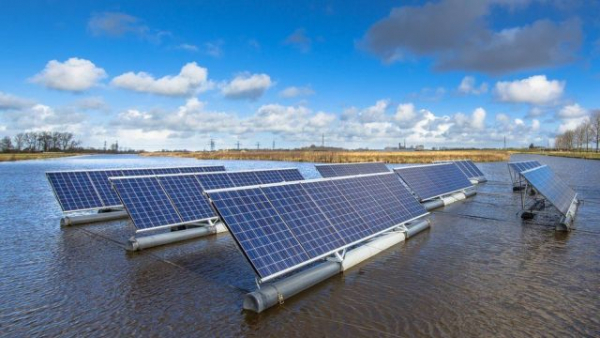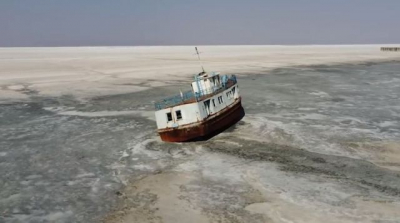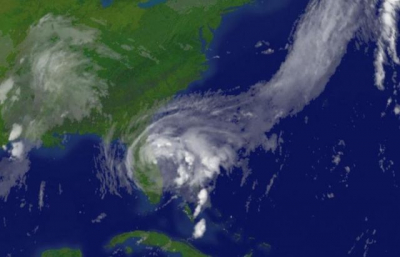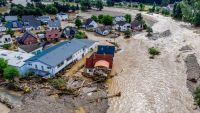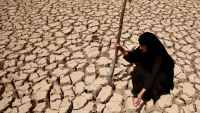The two-year-long experiment suggests that the data centers of the future might be aquatic.
Two years ago, Microsoft packed more than 800 computer servers into a tube the size of a shipping container — and then sank it to the bottom of the North Sea. The company’s goal? See whether an underwater data center could overcome the limitations of its terrestrial counterparts.
Microsoft has now retrieved its sunken data — and the results of the experiment suggest that the ocean could be a better home for data.
Temperamental Data Centers
Data centers are massive hubs that house servers and other equipment that companies rely on to store and distribute digital data — Google alone requires 20 dedicated data centers across the globe for its 2.5 million servers.
A problem with a data center can halt an entire company’s operations — Twitter, Facebook, and countless others can attest to that — and there are quite a few reasons why servers might go down.
“Computers are not designed to work in the environment that we humans operate,” Spencer Fowers, a researcher involved in Microsoft’s underwater data center, said. “Things like oxygen, moisture in the air — that is really bad for computers. It causes corrosion on the components.”
“You also get things like temperature fluctuations,” he continued, “so the heat from night to day and summer to winter can cause those components to fail.”
Even something as seemingly minor as a data center worker bumping into or moving equipment can disrupt its functionality, according to Fowers.
Microsoft’s Underwater Data Center
Microsoft built its underwater data center to test a theory that it’s not only possible to house the facilities under the ocean, but also beneficial.
For one, the location of the center — 100 feet below the ocean’s surface — would allow it to avoid some of the temperature fluctuations that can impact a traditional facility’s reliability.
The cold water around the center would also help prevent the equipment from overheating. By designing the underwater data center to function autonomously, Microsoft could also eliminate any chance of workers damaging equipment. And without humans, there’s no need for oxygen in a data center, so Microsoft could replace it with nitrogen, which is less corrosive to equipment.
In July, Microsoft retrieved the data center from the ocean floor — and based on early analysis, it seems the theory worked.
After two years, just eight of the 855 servers in the underwater data center had failed — a rate just one-eighth of that experienced on land, Microsoft researcher Ben Cutler said in a news release.
The team is now studying the equipment housed within the data center to figure out why it was more reliable. After that, the focus will be on exploring ways to scale up, perhaps by linking multiple underwater data centers together.
“We think that we’re past the point where this is a science experiment,” Cutler told the BBC. “Now it’s simply a question of what do we want to engineer — would it be a little one, or would it be a large one?”
By Kristin Houser
www.freethink.com
New analysis shows how companies can target renewable-energy purchases and investments to reduce water risk and carbon emissions in tandem.
Dwindling supplies of freshwater pose a material business risk: one estimate shows that the lack of clean fresh water threatens some $425 billion of value across more than 500 companies. Companies with water-intensive operations are apt to be attuned to water risk. But all companies can be indirectly exposed to water risk through their purchases of electricity, for water is widely used to generate electricity from steam-powered turbines. By contrast, electricity from renewable sources is generally less water-intensive than electricity from fossil fuels. A promising way for businesses to lessen their risk exposure while helping relieve local water stress, therefore, is to make greater use of renewable power, whether by sourcing a larger share of grid power from renewable sources or by installing their own renewable-generation capacity.
It’s also well known that switching to renewables can help reduce carbon emissions—something that companies are increasingly seeking to do, given the need to limit the buildup of physical climate risks by achieving net-zero emissions. These dual water and climate benefits of renewable power can be significant and should be considered in tandem. The idea that energy management affects water stewardship and climate stewardship is not new: the so-called energy-water-carbon nexus has long been a focus of academic research related to a wide variety of topics, such as seawater desalination. But it is increasingly relevant to multinational companies’ decisions about how to reduce their water footprints in water-scarce regions and lower their carbon emissions.
Assessing the potential water and carbon savings from using more renewable energy requires a granular analysis of site-level factors, ideally guided by a company-level strategy. To ascertain how these factors play out at the industry level, we analyzed data from more than 1,500 companies on the water consumption and carbon emissions associated with their electricity purchases in 2019 and then looked closely at two industries: chemicals, and food-and-beverage processing. (We selected these two industries because both had large data samples with extensive location footprints.)
Two site-level factors stood out in our analysis for both industries. The first factor is the water and carbon intensity of electricity purchased from the power grid; this varies considerably among regions. The second factor is the degree of water stress in the locations where a business operates, which also differs from region to region. For the chemical companies in our data set, 40 per cent of energy purchases take place in regions with medium-high or higher levels of water stress, compared with 25 per cent for food-and-beverage-processing companies. In this article, we show how considering these factors together can help executives maximize the water and carbon benefits of switching to renewable energy where feasible.
Locating opportunities to reduce water consumption and carbon emissions
Companies’ purchases of electricity from the grid affect local water quality and availability because the fossil fuel and nuclear power plants that generate most of the world’s electricity withdraw considerable freshwater to support their operations. Some power plants discharge some or all of that water back into the local basin, which lessens their impact on water availability. The water that is not discharged is said to be consumed, and water consumption reduces the quantity available locally. Our analysis focuses on water consumption because it tends to increase water stress. By contrast, wind farms and solar arrays consume little to no freshwater; at most, water is used to clean solar panels.
In general, countries that generate less grid power from renewable sources consume water at higher rates per unit of purchased electricity (Exhibit 1). Looking at the sources of grid power for the 119 countries covered by the data set, we found that 47 per cent generate less than 1 per cent of their grid power using wind or solar. Only 9 per cent of countries generate more than 5 per cent of their power from wind or solar. To find promising opportunities to reduce water consumption and carbon emissions by switching to renewables—through power-purchase agreements or self-operated renewable installations—companies might prioritize operations in countries with electricity grids that rely less on solar and wind power.

The other factor that bears consideration is water stress. Using the information on the water-stress levels of countries, we assessed exposures to water stress for the companies in two sectors within the data set: 111 companies in the chemicals industry and 86 companies in the food and beverage processing industry. In total, the 111 chemical companies reported 209 terawatt-hours (TWh) of purchased energy; our estimates indicate that this energy use resulted in 89 megatons of carbon emissions and 16 billion gallons of water consumed. The 86 food-and-beverage-processing companies reported purchasing 102 TWh of purchased energy, resulting in 39 megatons of carbon emissions and eight billion gallons of water consumed, according to our estimates.
When it comes to managing water impact, companies should know how much of their energy consumption takes place in regions and countries that experience greater water stress. The food and beverage-processing companies that we analyzed purchased 20 per cent of their grid power in countries with medium to high or higher levels of water stress. The resulting water and carbon impacts were disproportionately large, accounting for 56 per cent of the companies’ water consumed, and 32 per cent of their carbon emissions. Companies in the chemicals sector recorded a higher fraction of their energy purchases in water-stressed countries, 40 per cent, which accounted for 44 per cent of the sector’s water consumption and 49 per cent of carbon emissions from purchased energy (Exhibit 2). Across both sectors, energy purchases in water-stressed countries accounted for outsize shares of water consumption and carbon emissions, suggesting an opportunity to reduce both by switching to renewables in those countries.

Estimating the effects of switching to renewables
Next, we estimated the potential water and carbon reductions that would result as companies replaced nonrenewable sources of purchased energy (starting with coal power, then oil power, then gas power) with renewables. Adjustments were applied at the country level, to account for variations in the shares of nonrenewable power generated by using different fossil fuels. These variations can make for large differences in the water intensity of nonrenewable electricity: for example, nonrenewable-power generation in Mexico consumes nearly twice as much water, per kilowatt-hour, as in Egypt.
Substituting renewables for the most carbon-intensive energy sources had a profound impact on emissions, even when the increases in renewables were modest. In the chemicals sector, we estimate that lowering the share of nonrenewable energy by five percentage points and increasing the share of renewable energy by five percentage points would reduce carbon emissions from purchased energy by approximately 40 per cent. The same five-percentage-point change in purchased energy had an even greater effect in the food-and-beverage-processing sector: a 58 per cent reduction in carbon emissions. Upping the share of renewables by 50 percentage points would prevent 78 per cent of carbon emissions for chemical companies and 84 per cent of carbon emissions for food-and-beverage processors (Exhibit 3).
Chemical companies that substitute renewables for carbon-intensive energy sources can reduce emissions significantly.
Carbon-emissions reduction by the amount of renewable energy replacing nonrenewable energy, %
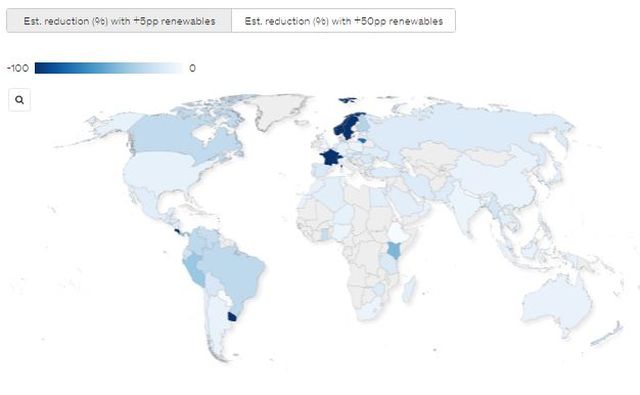
The water savings from switching to renewables were also significant. A 50-percentage-point increase in purchases of renewables results in a nearly 60 per cent reduction in water consumption for both the chemical companies and the food-and-beverage-processing companies (Exhibit 4).
Chemical companies that substitute renewables for carbon-intensive energy sources can reduce emissions significantly.
Carbon-emissions reduction by the amount of renewable energy replacing nonrenewable energy, %

Switching to renewables may not be a practical near-term option in every country where a company operates. Utilities might lack the renewable-generation capacity to supply a company with all the renewable energy that it needs. And adding capacity takes time, whether the utility do so or the company sets up its own renewable installations. Companies might therefore take a more gradual approach to increase their use of renewable energy. Some companies have also made renewable-power purchasing agreements with local utilities. These enable the utilities to accelerate investment in renewable installations by ensuring long-term demand for the electricity that the installations produce.
To illustrate the effect of a more gradual and targeted ramp-up in renewable-energy purchasing, we modelled the reductions in water consumption and carbon emissions that the two sets of companies would achieve if they increased their use of renewable energy only in countries with medium to high or higher levels of water stress. A five-percentage-point increase in renewable-energy use in water-stressed countries would reduce water consumption by around 6 per cent for both groups of companies; with a 50-percentage-point increase in renewables, they would lower water consumption by about 60 per cent for both groups. In other words, increasing the use of renewables in water-stressed countries results in an appreciable decrease in water consumption—the sort of result that can help guard against water risk.
What’s more, switching to renewables in water-stressed countries alone produces significant reductions in carbon emissions. With a five-percentage-point increase in renewables in water-stressed countries alone, we estimate that the chemical companies would lower their global carbon emissions by 13 per cent; for food-and-beverage-processing companies, the reduction would be 7 per cent. A 50-percentage-point increase in renewables in water-stressed countries would lower chemical companies’ global carbon emissions by 36 per cent, and food-and-beverage-processing companies’ emissions by 23 per cent overall (Exhibit 5).

Making the switch to renewables: How to begin
Business leaders in all industries face questions from investors, regulators, and other stakeholders about their companies’ impact on the climate and on local water basins and about the actions being taken to manage both types of impact. Increasing the use of renewable energy represents one potential action that companies might take as part of a balanced, comprehensive approach to improving both water efficiency and carbon efficiency, mitigating related risks, and supporting sustainable, inclusive growth for the communities where they operate. Here are five actions that executives can take to support such an approach:
- Evaluate the company’s energy purchases and the resulting water consumption and carbon emissions in the aggregate as well as at the level of individual sites and for both direct operations as well as purchased electricity. For water, in particular, location-specific assessments matter because levels of water stress differ from place to place.
- Set integrated targets rather than separate ones for lessening water consumption and carbon emissions. In doing so, management might benchmark the company’s activities against those of its peers.
- Think cross-functionally about how water and carbon programs can support each other. This article has focused on how companies can manage electricity sourcing for both water and carbon impact. But many business operations result in both water consumption and carbon emissions. Carbon-management efforts related to other areas, such as manufacturing processes, could be expanded to address water consumption, and vice versa.
- Collaborate with others in and beyond the direct value chain. When it comes to managing water and carbon impact by changing the types and sources of energy they use, companies that do business in a given locale may wish to explore joint sourcing of renewables and collaborative stewardship of water resources. Especially in areas with high levels of water stress, companies might consider coordinating their activities and consulting local stakeholders to devise water-management plans that don’t put undue strain on shared local resources.
- Engage local utilities and regional or municipal authorities to understand their plans for phasing out fossil fuels and for increasing renewable capacity, then seek ways of working together to hasten the transition. If businesses voice interest in or commit to purchasing more renewable energy, they can encourage utilities to make needed capital investments.
Water and carbon priorities don’t need to be at odds. An integrated renewable-energy strategy can address these two sets of priorities at once, enhancing the company’s performance and improving its standing with stakeholders.
ABOUT THE AUTHOR(S)
Alyssa Bryan is a consultant in McKinsey’s Charlotte office; Thomas Hundertmark is a senior partner in the Houston office, where Kun Lueck is a partner; Wilson Roen is a consultant in the Chicago office; Giulia Siccardo is an associate partner in the San Francisco office; Humayun Tai is a senior partner in the New York office, and Jason Morrison is the president of the Pacific Institute and head of the UN Global Compact’s CEO Water Mandate.
The authors wish to thank Daniel Aminetzah, Anjan Asthana, Taylor Bacon, Gualtiero Jaeger, Joshua Katz, Adam Kendall, Kee Wen Ng, and Dickon Pinner from McKinsey; Peter Schulte from the Pacific Institute; and the member companies of the UN Global Compact’s Water Resilience Coalition for their contributions to this article.
This article was edited by Josh Rosenfield, an executive editor in the New York office.
Croatia is preparing its first subsidy program for heat pumps that use seawater for heating and cooling. Professor Neven Duić says the technology could be used throughout the Adriatic coast and for buildings near rivers and lakes.
The Ministry of Regional Development and EU Funds will issue a public call by the end of the month for using sea temperature to provide heating and cooling, Jutarnji.hr reported. It is the first scheme in Croatia designed specifically for the purpose since it started drawing European Union funds, according to the article.
The draft refers to converting energy from the sea in general, but the only eligible technology this time will be heat pumps that would use seawater for buildings on the coast, the media outlet revealed and added the budget is EUR 1.5 million.
Much of the Balkans could be heated
Professor at the Faculty of Mechanical Engineering and Naval Architecture at the University of Zagreb Neven Duić praised the plan and stressed all the hotels on the Adriatic shore and cities with district heating systems could benefit from such subsidies.
“There is a possibility to install heat pumps in a big part of the coast. Areas near big rivers like the Sava and Danube are also suitable, but the technology can also be implemented next to lakes. Actually, Stockholm has been using municipal wastewater for heating for many years. Groundwater can also be utilized. Palace Hotel Zagreb installed such a system,” he told Balkan Green Energy News.
Using wave or tidal energy as well as seawater heat exchangers is still in the early stages in the European Union, but they are included in the solutions supported through a massive financial package within the European Green Deal. Croatia has a long sea coast, which makes the heating and cooling technology especially beneficial, the ministry said, as quoted by the news website.
Local authorities are eligible for funds for seawater heat pumps
Investment costs could be high, but the pilot project should still be examined, the draft reads. Its content reveals municipalities and cities would be able to apply, among other potential beneficiaries.
Associate Professor at the Faculty of Mechanical Engineering and Naval Architecture Goran Krajačić suggested the government should define concession terms for using seawater or simplify the environmental assessment procedure for specific cases. But the proposed public call will be very useful in the meantime, he asserted.
Krajačić stressed several such projects were implemented in the 1980s in the country from the Istria peninsula in the north down to Dubrovnik.
As for Dubrovnik, one heating and cooling endeavour with seawater heat pumps was completed less than two years ago.
The government earmarked EUR 1.5 million for scientists and investors, according to the draft public call, where the maximum for an individual project would be 1.3 million or 50%, the report revealed. It added the contracts would have to be signed by May and that the projects have to be implemented by April 2024.
Author Igor Todorović
https://balkangreenenergynews.com/
The ferries that once shuttled tourists to and from the little islets in Iran's Lake Urmia sit rusty, unable to move, on what is rapidly becoming a salt plain. Just two decades ago, Urmia was the Middle East's biggest lake, its local economy a thriving tourist center of hotels and restaurants.
"People would come here for swimming and would use the mud for therapeutic purposes. They would stay here at least for a few days," said Ahad Ahmed, a journalist in the former port town of Sharafkhaneh as he showed CNN photos of people enjoying the lake in 1995.
Lake Urmia's demise has been fast. It has more than halved in size -- from 5,400 square kilometers (2,085 square miles) in the 1990s to just 2,500 square kilometers (965 square miles) today -- according to the Department of Environmental Protection of West Azerbaijan, one of the Iranian provinces where the lake is located. There are now concerns it will disappear entirely.
Such problems are familiar in many parts of the Middle East -- where water is simply running out.
The region has witnessed persistent drought and temperatures so high that they are barely fit for human life. Add climate change to water mismanagement and overuse, and projections for the future of water here are grim.
Some Middle Eastern countries, including Iran, Iraq and Jordan, are pumping huge amounts of water from the ground for irrigation as they seek to improve their food self-sufficiency, Charles Iceland, the global director of water at the World Resources Institute (WRI), told CNN. That's happening as they experience a decrease in rainfall.
"They're using more water than is available routinely through rain. And so groundwater levels are consequently falling because you're taking water out faster than it's being replenished by the rainfall," he said.
That's what's happening in Iran, where a vast network of dams sustains an agricultural sector that drinks up about 90% of the water the country uses.
"Both declining rainfall and increasing demand in these countries are causing many rivers, lakes, and wetlands to dry up," Iceland said.
The consequences of water becoming even scarcer are dire: Areas could become uninhabitable; tensions over how to share and manage water resources like rivers and lakes could worsen; more political violence could erupt.
In Iran, Urmia has shrunk largely because so many people have exploited it, and some of the dams built in its basin mainly for irrigation have reduced the flow of water into the lake.
Iran's water woes are already a deadly issue. In one week in July, at least three protesters were killed in clashes with security officers in demonstrations against water shortages in the country's southwest.
The country is experiencing some of the driest conditions in five decades, according to the country's meteorological service.
The Middle East's winters are projected to get drier the more the world warms, and while the summers will be wetter, the heat is expected to offset its water gains, according to scientists' latest projections published earlier this month by the UN Intergovernmental Panel for Climate Change report.
"The problem is, with this whole temperature rise, whatever rainfall will come will evaporate because it is so hot," Mansour Almazroui, director at the Center of Excellence for Climate Change Research at Saudi Arabia's King Abdulaziz University, told CNN.
"The other thing is, "This rain is not necessarily going to be usual rain. There's going to be extreme rainfall, meaning that floods like those happening in China, in Germany, in Belgium, these floods will be a big problem for the Middle East. This is really a big climate change issue."
A study by the Iranian Energy Ministry found the demise of the lake was more than 30% attributable to climate change.
These changes are not only having an impact on the amount of water available, they are also affecting quality.
Lake Urmia is hypersaline, meaning it's very salty. As it has shrunk, the salt concentration has increased and gotten so extreme, using it for irrigation is damaging farmers' crops.
Kiomars Poujebeli, who farms tomatoes, sunflowers, sugar beet, eggplant and walnuts near the lake, told CNN that the salty water has been disastrous.
"The day the soil will become unfarmable is not far away," he said.
A vicious cycle
In Jordan, one of the most water stressed countries in the world, people have become used to living with very little water.
A study published in the Proceedings of the National Academy of Sciences showed that Jordanians will have to halve their per capita use of water by the end of the century. Most Jordanians on lower incomes will live on 40 liters a day, for all their needs -- drinking, bathing and washing clothes and dishes, for example. The average American today uses around 10 times that amount.
In many Jordanian homes, water isn't necessarily available every day, said Daniel Rosenfeld, a professor with the Program of Atmospheric Sciences at The Hebrew University of Jerusalem.
"Jordan now has a critical shortage of water -- water reaches the houses in Jordan once or twice a week, even in the capital Amman," Daniel Rosenfeld, a professor with the Program of Atmospheric Sciences at The Hebrew University of Jerusalem. The capital actually has existential problems right now, already," Rosenfeld said.
The Middle East is at the center of an increasingly water-stressed world
Water stress, which occurs when the demand for water exceeds the available supply, is already starkest in the Middle East and its surrounding countries, and is projected to get worse within the next decade.
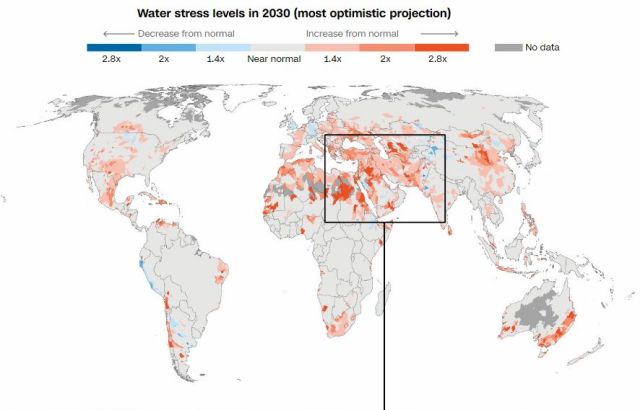
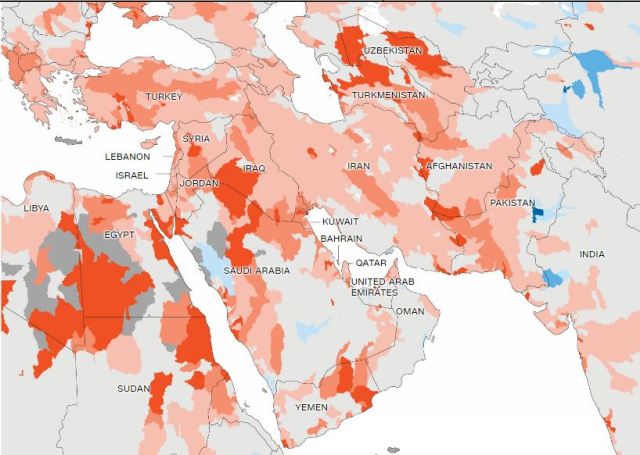
Source: World Resources Institute; Graphics: Priya Krishnakumar, CNN
Groundwater levels in parts of the country are dropping by well over one meter a year, studies show, and waves of refugees from many countries in the region have put extra pressure on the already stressed resource.
The secretary-general of Jordan's Water Authority, Bashar Batayneh, told CNN that the country needs more funding from the rest of the world to deal with this increased demand for water.
"Jordan bore the heavy load of the Syrian refugee crises on behalf of the international community and was deeply impacted regarding water. Refugees cost the water sector over $600 million per year while Jordan received a fraction of this amount from the international community," he said.
He added that Jordan had much less rain in 2020 than it did the previous year, putting more than a quarter of water resources at risk and halving drinking water sources.
But it's not only climate change. The country relies on the Jordan River system, which also runs through Israel, the West Bank, Syria and Lebanon, and dams building along the rivers have severely cut the flow of water flow to Jordan. Jordan, too, uses canals to redirect the river's waters for irrigation. Conflict has flared several times around the river system in the past.
It's a transboundary problem also seen in other parts of the region along the Euphrates and Tigris rivers, as well as in northern Africa along the Nile.
Jordan, Israel and Syria have gotten better at coordinating management of the river system they rely on, but tensions often erupt. Experts have long warned that water scarcity worsened by climate change could lead to more conflict.
Jordan has little choice but to buy large amounts of water from Israel, which has an enormous desalination program, in which it removes salt from seawater to make it fit for human consumption. But desalination is energy-intensive -- using up huge amounts of energy; energy that is not yet green and renewable, and only adds to global warming, a major driver of water scarcity in the first place.
As the climate continues to warm and water runs scarce, part of the solution in the Middle East will have to involve reducing water use in agriculture. That can also mean changing the kind of food farmers grow and export, Rosenfeld said.
"In Israel, for example, we used to grow a lot of oranges, but at some point, we realized that we are exporting water that we don't have," he said, adding that crops could also be engineered to be more resilient to heat and dryness.
And Almazroui, from King Abdulaziz University, said that dams could be better organized to consider changing rain patterns. Coordination on managing rivers that flow across countries also has to improve.
But that's not going to help a farmer whose family has owned land for generations and can't necessarily move to wetter climes, or has little control over where a neighboring country might build a dam.
Raad al-Tamami, a 54-year-old father of five who lives in Diyala province northeast of Baghdad, relies on the Diyal River, a tributary to the Tigris River, for water.
The Diyal has been drying up for years and has forced al-Tamami to halve his fruit production across his three farms.
He and his fellow farmers are working on a water rationing schedule, and he sometimes waits up to a month for the water to come.
This dependence on more water to ensure food security could ironically put the availability of food at risk -- farmers are only going to keep farming under these difficult conditions for so long.
That's what plagues al-Tamami's mind all the time.
"Many farmers, including me, are seriously considering leaving this profession, which is inherited from father, from grandfather, and to start looking for more profitable jobs that guarantee a better future for our children."
By Frederik Pleitgen, Claudia Otto, Angela Dewan and Mohammed Tawfeeq, CNN
A material found in the wood of our plants is being trialled as a way to produce sustainable battery power.
Finnish designers Stora Enso have built a new production facility costing €10 million that will create renewable bio-based carbon by turning trees into batteries. This will be achieved by the use of a wood-based material called lignin.
The plant is based beside the company’s Sunila Mill in Kotka, southern Finland, which employs over 150 people and specialises in producing softwood pulp, and biofuels like tall oil and turpentine.
The company is responsible for developing a number of wood and biomaterial-based solutions for everyday problems that require eco-friendly solutions. Their innovative product offerings range from mouldable woods to formed fiber food packaging.
What is lignin and how is it formed into batteries?

The tree powder is pressed into strips as a substitute for non-renewable graphiteStora - Enso
Not to be confused with the Swedish berry, lignin is nature’s second most common macromolecule after cellulose, deposited in the cell wall of plants to make their structure firm and woody to prevent them from rotting. It makes up around a third of all wood’s total composition.
Stora Enso have been long-term investors in sustainable research and development funding with investments of €140 million last year. Confidence levels are high that the carbon contained within the non-toxic material can be used to replace the fossil fuels and mined metals found in our lithium-ion batteries, which usually require graphite to function.
Lignin is separated from wood during the production of cellulose fibers from its pulp. It’s then refined into a lightweight carbon powder which is made into electrode sheets and combined with other battery components in order to replace graphite.
The company has been producing lignin industrially at Sunila Mill since 2015. Their annual production capacity is 50,000 tonnes, making Stora Enso the world's largest producer of kraft lignin. Expanding lignin into its own production quarters, along with patenting the technology under the title Lignode®, cement Stora’s intentions for a future of smarter battery travel.
What are the advantages of tree-sourced battery technology?
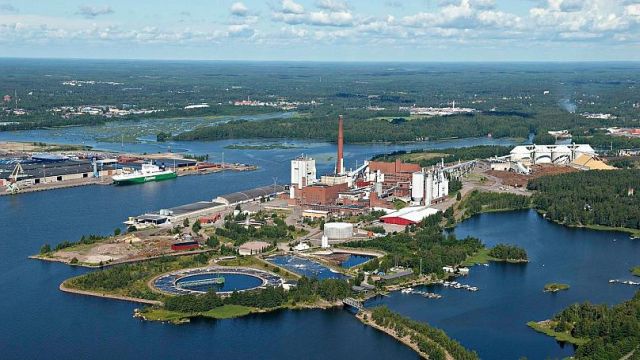
The €10 million lignin production facility is an extension of Stora Enso's current biomaterials mill in Kotka, FinlandStora Enso
The anode in traditional lithium-ion batteries is made from graphite which is formed through a chemical reaction in unrenewable carbon compounds.
In order for Tesla to meet its production targets of 20 million electric cars annually, it would need to mine over 1 million tonnes of graphite.
Almost all portable electronics are now powered by lithium-ion batteries. There are some concerns that engineers can’t make future commitments to them as means of powering larger machinery, such as aeroplanes, due to their capacity to overheat.
This was most poignantly evidenced by the infamous thermal overheating incident on a Boeing 787 Dreamliner’s flight from Washington to Charles de Gaulle Airport, Paris, though Boeing maintains there is no inherent safety risk to large automotive batteries used in this way.
Stora Enso has outlined five key benefits to transitioning to their renewable Lignode energy technology:
Scalability
- It is viable to produce these batteries commercially due to the wide availability of the resource required to make them - trees.
Sustainability
- The manufacturers pledge to source their materials from sustainability-certified European forests.
Renewability
- Almost all LI battery manufacturing takes place in China because of weak environmental standards and cheap production costs. Using natural resources would eradicate this need entirely.
Faster charging
Stora Enso believe a fully functional Lignode battery has the capacity to charge at a faster rate than the fossil-fuel powered market leader.
Better performance at lower temperatures
- The battery is operational under cooler temperatures, opening doors to powering more electric automotives.
Meeting global demand for e-mobility

Electric cars, bikes, and scooters are experiencing a period of unprecedented - growthCanva
Lignin-based carbon could go on to be used to power everything from consumer electronics to automotive systems. The latter appears to be the company’s most pressing concern, given the exponential rise of e-mobility.
It is expected to be a large contributor to the global battery market increasing tenfold in the next five years. A panel by PwC on the topic noted that the pandemic induced a 14 per cent decline in general automotive sales, contrasted by a “outstanding growth” of 46 per cent in electric vehicles such as e-bikes and scooters globally.
It could provide excellent news for our vehicle-rooted carbon emissions, but only if the materials to make them come at less cost to our environment.
“With Lignode, we can provide a bio-based, cost-competitive and high-performance material to replace the conventionally used graphite,” says Markus Mannström, Executive Vice President of Stora Enso’s Biomaterials division.
“To serve the fast-growing anode materials market, we are now exploring strategic partnerships to accelerate scale-up and commercialisation in Europe.”
By Shannon McDonagh
https://www.euronews.com/
A shutdown would have devastating global impacts and must not be allowed to happen, researchers say
Climate scientists have detected warning signs of the collapse of the Gulf Stream, one of the planet’s main potential tipping points.
The research found “an almost complete loss of stability over the last century” of the currents that researchers call the Atlantic meridional overturning circulation (AMOC). The currents are already at their slowest point in at least 1,600 years, but the new analysis shows they may be nearing a shutdown.
Such an event would have catastrophic consequences around the world, severely disrupting the rains that billions of people depend on for food in India, South America and West Africa; increasing storms and lowering temperatures in Europe; and pushing up the sea level off eastern North America. It would also further endanger the Amazon rainforest and Antarctic ice sheets.
The complexity of the AMOC system and uncertainty over levels of future global heating make it impossible to forecast the date of any collapse for now. It could be within a decade or two, or several centuries away. But the colossal impact it would have means it must never be allowed to happen, the scientists said.
“The signs of destabilisation being visible already is something that I wouldn’t have expected and that I find scary,” said Niklas Boers, from the Potsdam Institute for Climate Impact Research in Germany, who did the research. “It’s something you just can’t [allow to] happen.”
It is not known what level of CO2 would trigger an AMOC collapse, he said. “So the only thing to do is keep emissions as low as possible. The likelihood of this extremely high-impact event happening increases with every gram of CO2 that we put into the atmosphere”.
Scientists are increasingly concerned about tipping points – large, fast and irreversible changes to the climate. Boers and his colleagues reported in May that a significant part of the Greenland ice sheet is on the brink, threatening a big rise in global sea level. Others have shown recently that the Amazon rainforest is now emitting more CO2 than it absorbs, and that the 2020 Siberian heatwave led to worrying releases of methane.
The world may already have crossed a series of tipping points, according to a 2019 analysis, resulting in “an existential threat to civilisation”. A major report from the Intergovernmental Panel on Climate Change, due on Monday, is expected to set out the worsening state of the climate crisis.
Boer’s research, published in the journal Nature Climate Change, is titled “Observation-based early-warning signals for a collapse of the AMOC”. Ice-core and other data from the last 100,000 years show the AMOC has two states: a fast, strong one, as seen over recent millennia, and a slow, weak one. The data shows rising temperatures can make the AMOC switch abruptly between states over one to five decades.
The AMOC is driven by dense, salty seawater sinking into the Arctic ocean, but the melting of freshwater from Greenland’s ice sheet is slowing the process down earlier than climate models suggested.
Boers used the analogy of a chair to explain how changes in ocean temperature and salinity can reveal the AMOC’s instability. Pushing a chair alters its position, but does not affect its stability if all four legs remain on the floor. Tilting the chair changes both its position and stability.
Eight independently measured datasets of temperature and salinity going back as far as 150 years enabled Boers to show that global heating is indeed increasing the instability of the currents, not just changing their flow pattern.
The analysis concluded: “This decline [of the AMOC in recent decades] may be associated with an almost complete loss of stability over the course of the last century, and the AMOC could be close to a critical transition to its weak circulation mode.”
Levke Caesar, at Maynooth University in Ireland, who was not involved in the research, said: “The study method cannot give us an exact timing of a possible collapse, but the analysis presents evidence that the AMOC has already lost stability, which I take as a warning that we might be closer to an AMOC tipping than we think.”
David Thornalley, at University College London in the UK, whose work showed the AMOC is at its weakest point in 1,600 years, said: “These signs of decreasing stability are concerning. But we still don’t know if a collapse will occur, or how close we might be to it.”
By Damian Carrington
Environment editor
https://www.theguardian.com/
A new study tracking the planet’s vital signs has found that many of the key indicators of the global climate crisis are getting worse and either approaching or exceeding, key tipping points as the earth heats up.
Overall, the study found some 16 out of 31 tracked planetary vital signs, including greenhouse gas concentrations, ocean heat content and ice mass, set worrying new records.
“There is growing evidence we are getting close to or have already gone beyond tipping points associated with important parts of the Earth system,” said William Ripple, an ecologist at Oregon State University who co-authored the new research, in a statement.
“The updated planetary vital signs we present largely reflect the consequences of unrelenting business as usual,” said Ripple, adding that “a major lesson from Covid-19 is that even colossally decreased transportation and consumption are not nearly enough and that, instead, transformational system changes are required.”
While the pandemic shut down economies and shifted the way people think about work, school and travel, it did little to reduce the overall global carbon emissions. Fossil fuel use dipped slightly in 2020, but the authors of a report published in the journal BioScience say that carbon dioxide, methane and nitrous oxide “have all set new year-to-date records for atmospheric concentrations in both 2020 and 2021”.
In April 2021, carbon dioxide concentration reached 416 parts per million, the highest monthly global average concentration ever recorded. The five hottest years on record have all occurred since 2015, and 2020 was the second hottest year in history.
The study also found that ruminant livestock, a significant source of planet-warming gases, now number more than 4 billion, and their total mass is more than that of all humans and wild animals combined. The rate of forest loss in the Brazilian Amazon increased in both 2019 and 2020, reaching a 12-year high of 1.11 million hectares deforested in 2020.
Ocean acidification is near an all-time record, and when combined with warmer ocean temperatures, it threatens the coral reefs that more than half a billion people depend on for food, tourism dollars and storm surge protection.
However, there were a few bright spots in the study, including fossil fuel subsidies reaching a record low and fossil fuel divestment reaching a record high.
In order to change the course of the climate emergency, the authors write that profound alterations need to happen. They say the world needs to develop a global price for carbon that is linked to a socially just fund to finance climate mitigation and adaptation policies in the developing world.
The authors also highlight the need for a phase-out and eventual ban of fossil fuels, and the development of global strategic climate reserves to protect and restore natural carbon sinks and biodiversity. Climate education should also be part of school curricula around the globe, they say.
“Policies to alleviate the climate crisis or any of the other threatened planetary boundary transgressions should not be focused on symptom relief but on addressing their root cause: the overexploitation of the Earth,” the report says. Only by taking on this core issue, the authors write, will people be able to “ensure the long-term sustainability of human civilization and give future generations the opportunity to thrive”.
By Katharine Gammon
https://www.theguardian.com/
Four days before deadly floods swept through western Germany and parts of Belgium last week, Hannah Cloke saw a forecast of extreme rain on a Europe-wide flood alert system to which she belongs. Researchers “were stupidly congratulating ourselves that we were forecasting something so early. … The assumption was that would be really helpful,” says the hydrologist and flood forecaster at the University of Reading. Instead, she was stunned to see scenes of devastation and death despite the ample warnings. “We should not be seeing this number of people dying in 2021 from floods. It just should not be happening.”
As the magnitude of the destruction becomes clear, European scientists are wrestling with how such damage could happen in some of the world’s wealthiest and most technologically advanced countries, despite major investments in flood forecasting and preparation catalyzed by previous inundations. And they are examining whether climate change helped fuel the disaster—and what that might mean for the future.
Beginning on 13 July, intense storms dropped as much as 15 centimetres of rain in 24 hours, swelling streams that then washed away houses and cars and triggered massive landslides. At least 196 people had died as of 20 July—165 in Germany and 31 in Belgium—and the number is expected to rise. On 18 July, German Chancellor Angela Merkel visited the stricken town of Adenau. The scene was “terrifying,” she said. “The German language can barely describe the devastation.” That same day more flash floods struck Bavaria, in southern Germany.
Researchers are just beginning to unravel the complex web of climatic, hydrological, and social factors that contributed to the catastrophe. But they already have some suspects in mind, including a warming climate that can supercharge rainstorms and European disaster plans that focused on major rivers, rather than the lower volume tributaries hit hardest by the storms.
“We’ve been concentrating a lot on the big rivers,” says William Veerbeek, an urban flood management expert at the IHE Delft Institute for Water Education. “There’s still a lot more to do in the smaller streams.”
For years, scientists have warned climate change will mean more flooding in Europe and elsewhere. Warmer air holds more moisture, which can translate into heavier rainfall. By 2100, flood damage on the continent could cost as much as €48 billion per year—up from €7.8 billion now—if nothing more is done to prepare, and the number of people affected could more than double to some 350,000, according to the European Commission’s Joint Research Centre.
Some European rivers are already exhibiting climate-related changes, says Fred Hattermann, a hydrologist and flood expert at the Potsdam Institute for Climate Impact Research. Along the Danube River, for example, floods that once came every 50 years now happen roughly twice as often, according to recent unpublished work the institute conducted with the German insurance industry.
New research suggests such risks could grow if climate change slows the jet stream—the high-altitude winds circling the Northern Hemisphere—causing drenching rainstorms to linger longer over flood-prone landscapes. Storms that stall over Europe were once exceedingly rare. But according to a study published last month in Geophysical Research Letters, in a worst-case scenario, such storms could become as much as 14 times more common in 2100 than they were at the start of this century.
The exact weather pattern driving the current storm is different, says the paper’s lead author, hydroclimatologist Hayley Fowler of Newcastle University. But the overall dynamic is similar, she adds: A slow-moving storm overwhelms a region’s river system.
Floods already rank as the most destructive natural hazard in Northern Europe. Past events—including deadly floods in 2002—led the European Commission to launch the European Flood Awareness System, meant to provide emergency managers with early warnings. But last week the speed and intensity of the flooding in Germany—especially in towns perched next to smaller creeks—took most people by surprise. “There was simply no time,” Hattermann says. “Then, of course, people run to save their cars and whatever and bad things happen.”
In the Netherlands, decades of preparation appear to have helped. Even though the Meuse River, which runs through eastern Belgium and into the Netherlands, broke a high flow record set in 1993, it caused far less damage. A tributary of the Meuse flooded the city center of Valkenburg in the south, but no deaths were reported.
Dutch policies aimed at making “room for the river” have widened and deepened river channels, and set aside land where floodwaters can spread out. Those measures were projected to reduce flood peaks on the Meuse by as much as 1 meter, says Nathalie Asselman, a flood management expert and adviser to the Dutch government at Deltares, a research institute. Those predictions appear to be coming true. “When we look at how bad the flooding is, it’s much less than what happened in the ’90s,” she says.
Some researchers are examining how people responded to flood warnings. After the 2002 floods in eastern Germany, Bruno Merz, a hydrologist and civil engineer at the Helmholtz Centre Potsdam of the German Research Centre for Geosciences, surveyed residents. One-third of the people who received flood warnings reported having “no clue” what to do next. Now, Merz wants to know whether such confusion contributed to the current death toll. “All the data shows … that when people get a warning and they take [it] seriously, they can rescue themselves,” he says. “They need 1 hour, not more.”
Merz also has some immediate and personal concerns about the floods. Last week, he learned that a swollen creek had swamped the ground floor of a vacation cottage—named “Brook view”—that his family had rented in a German village. The trip is still on; the landlord pleaded with Merz not to cancel because he needs the money. But, “If there are any problems,” Merz says, “we will just make a detour.”
By Warren Cornwall
https://www.sciencemag.org/
Street protests over water shortages in southwest Iran continued for a sixth night on Tuesday amid rising violence, while residents in the capital of Tehran chanted anti-government slogans, according to videos posted on social media on Wednesday and Iranian news outlets.
Several videos uploaded by social media users showed security forces using tear gas to disperse protesters, and the semi-official news agency Fars said "rioters" shot dead one policeman and injured another in the port city of Mahshahr in the Khuzestan province, the area worst affected by the water shortages.
Security forces have beefed up their presence in Tehran. At the capital's Azadi Square, anti-riot police were seen stationed with armoured vehicles.
A short video posted on Twitter by New York Times journalist Farnaz Fassihi showed people at a Tehran metro station chanting "death to the Islamic Republic" in a rare display of protest against the country's clerical elite. CNN has been unable to independently verify the video.
In the town of Izeh, a video showed demonstrators chanting "Reza Shah, bless your soul," a reference to the king who founded the Pahlavi dynasty which was overthrown by the 1979 Islamic Revolution.
At night, some people in the capital vented their anger with chants against Supreme Leader Ayatollah Ali Khamenei, Reuters reported.
Reuters could not independently authenticate the videos.
At least two young men have been shot dead in the protests. The official has blamed armed protesters, but activists said on social media they were killed by security forces. On Tuesday, a police officer died in the port city of Bandar-e Mahshahr after being shot from a rooftop by "rioters," state media said.
Iran's state media regularly makes inflated claims about "lawlessness" at protests, covering up police violence.
Iran's ethnic Arab minority, who mostly live in the oil-rich Khuzestan province, have long said they face discrimination in the country. An Arab woman protester could be heard shouting at security forces in one video: "Sir! Sir! The demonstration is peaceful. Why do you shoot? No one took your land and water."
Iran is facing its worst drought in 50 years and the water crisis has affected households, agriculture and livestock farming, and led to power blackouts.
A video on social media showed a group of activists gathering outside the Tehran Interior Ministry to voice support for Khuzestan protesters.
"We call on law enforcement forces not to harm protesters calling have access to water," a prominent activist, Narges Mohammadi, said in the video.
Iran's economy has been crippled partly by sanctions imposed mainly on its oil industry by former US President Donald Trump in 2018, as well as the Covid-19 pandemic. Workers, including thousands in the key energy sector, and pensioners have protested for months, with discontent growing over mismanagement, high unemployment and an inflation rate of more than 50%.
The governor of Khuzestan, Qasem Soleimani Dashtaki, promised to alleviate the water shortages within a year, which have affected at least 702 villages in the province, semi-official state media ISNA reported.
By Mostafa Salem Hande Atay Alam and Reuters
https://edition.cnn.com/
Residents of some of the worst-hit towns return to salvage what they can from their lives and businesses
It looks like a bomb went off. Everything’s destroyed. There’s nothing left of the city centre,” said Michaela Wolff, a winemaker from one of the German towns worst hit by last week’s catastrophic flooding.
Her family vineyard and guesthouse, the Weingut Sonnenberg, would normally be filled with tourists descending the red wine trail. This weekend it was filled with desperate refugees from homes destroyed when the Ahr burst its banks on Wednesday after days of heavy rain.
“We have water and we have electricity. The gas has been shut off, but we have more than most,” she said. “It’s chaotic, absolutely chaotic.”
Floods across western Germany and Belgium have killed at least 160 people, and the worst-hit area is the Ahrweiler district, which includes Wolf’s town of Bad Neuenahr.
Ninety-eight deaths have so far been confirmed there, among them 12 in a home for disabled people. Many more people are missing and the toll is expected to rise.
Thousands have also been made homeless, and the economic fallout from lost homes and businesses and the cost of repairing infrastructure is likely to run to billions.
Bad Neuenahr-Ahrweiler is a historic spa town surrounded by picturesque vineyards and populated by many small-scale vintners. Days of unrelenting rain earlier this week sent a wave of water several feet high down the Ahr, which divides the town in two.
The roads were left buried in water and mud, cars were tossed on to their sides in the square, and parts of buildings were swept away. One house was left gaping open to the street as if a bomb had blown away its front wall.
Wolff’s wine cellar was the only one in town to survive the wall of water, and it was a narrow escape: “The water stopped just centimetres from our doorstep. We had incredible luck.” Since the flood began receding, she has been working around the clock with her family to help with local clean-up and rescue efforts.
Beyond the terrible human toll, the damage to infrastructure, including roads, bridges and railways, is likely to take months to repair. The fallout is already prompting a political reckoning about the costs of climate change, with the Netherlands prime minister Mark Rutte on Friday directly blaming changing weather patterns for the intensity of flooding.
Asked whether global warming had contributed to the disaster, he said that was “without a doubt the case”. He added: “I don’t want to make hasty declarations … but something is really happening, let’s be clear.”
The floods come weeks after a record-breaking heatwave killed hundreds in Canada and the US. Scientists have said such extreme heat would have been “virtually impossible” without climate change.
Thirty miles north-west of Bad Neuenahr, the Blessem district of the town of Erftstadt appeared to have borne the brunt of an even greater disaster, as the overflowing Erft poured into a gravel quarry, triggering a landslide that collapsed houses and buried a motorway.

Abandoned vehicles on flooded highway 265 after a landslide caused by a major flood near Erftstad. Photograph: Adam Berry/Getty Images
The national guard and fire departments from around the country arrived with boats and diving teams to assist in search and rescue operations on Friday, and the dam was stabilised. But on Saturday it was deemed at risk of bursting again, sending those along the evacuation path scrambling.
No one was taking any chances after Thursday’s flooding, which seemed to have caught many in Erftstadt unprepared. When the quarry collapsed, it spilled on to the motorway, trapping lorries and cars on the major road connecting Cologne with the southern Eifel region.
Herbert Reul, the interior minister of North Rhine-Westphalia, said before operations to excavate vehicles that they expected to find some in up to 32ft of water.
The speed of the flooding and the number of people still missing mean the death toll is expected to rise. “We have to assume we will find further victims,” said Carolin Weitzel, mayor of Erftstadt.
In the centre of Erftstadt, residents were arriving at a flooded graveyard to lay stones and light candles out of respect for the dead. A family with young children was huddled at the cemetery’s entrance, in tears.
Next door, a supermarket closed by the flooding was handing out non-perishables and bottled water to deliver to those housed on nearby school grounds. About 80 of the evacuees have already been given shelter in nearby Cologne.
Others are being sent to cities across the region, unsure if they will be able to return home. And if they do, it’s unclear what the survivors will return to.
“There’s no more infrastructure,” said Wolff. “With the bridges gone, we’re cut off from the other side of the town. The numbers of dead keep rising every hour. Emotionally, we’re at our limit.
By Courtney Tenz
Published on Sat 17 Jul 2021
www.theguardian.com
More...
Desert plants – famous for tolerance of torrid landscapes – are dying at an alarming rate due to the twin threats of even hotter weather and less rain, according to last research.
After analyzing more than three decades of satellite data, University of California, Irvine, scientists found a 37% decline in native vegetation across nearly 5,000 square miles of the Southern California Sonoran Desert, from the Mexican border north across Anza-Borrego Desert State Park to Palm Springs, California.
Some scientists, including the study's lead author, Stijn Hantson, had hoped that hardy desert plants would be able to survive rising temperatures and less rain, but the research definitively shows the opposite.
"They're already so badly beaten by drought or heat that they're at the brink of existence," said Hantson, a UC Irvine project researcher. Add slightly hotter weather and even less moisture, and they perish, with nothing able to grow and replace them.
"They are not somehow super adapted to be able to withstand the effects of climate change," said co-author James Randerson, a biogeochemist and UC Irvine professor.
The researchers were particularly surprised at the role played by higher heat due to human-caused climate change in driving the plant loss. Plants and trees on the dry side of nearby mountains saw a slower rate of decline – only 13% – likely due to slightly lower temperatures.
The team analyzed Landsat satellite data from 1984, when higher definition readings became available, through 2017. The satellite passes overhead every 16 days, and researchers used near-infrared and red wavelength readings from summer months, when only native shrubs and trees are visible, to track striking declines in overall plant life.
The new satellite-based work offers a big picture perspective that is also helpful for scientists who are chronicling specific species succumbing at ground level.
"Satellite or remote sensing technology has really revolutionized what we can study without setting foot on the ground," said Lynn Sweet, a University of California, Riverside, a conservation biologist who studies desert plants just to the north of the study area, who was not part of the paper. "Many changes in where plants occur, how dense they are, and their condition can be detected using the different wavelengths of light reflected and absorbed on the ground. This is a really neat application of this technology. This has of course ramifications across the food chain."
In a cascading series of impacts, pollinator insects that rely on the vegetation for food and water, lizards that eat the bugs and the larger animals that rely on the reptiles – including already endangered species – are struggling harder as a result of plant loss, she and Randerson said.

At sunrise, fog descends on an ocotillo forest in Anza-Borrego Desert in Southern California. © Sicco Rood / Steele/Burnand Anza-Borrego Desert Research Center
The work doesn't identify specific species that are dying but complements efforts by researchers who are examining ocotillo, creosote bush, yucca, mesquite and other Sonoran Desert plants.
"The study is valuable because it provides an overall view of plant biomass and how it is being impacted by climate change, which includes warmer temperatures, a decline in precipitation... and a doubling of long-term droughts lasting three or more years," said veteran desert ecologist James Cornett, who was not affiliated with the new work.
"Because it relies on satellite imagery, it cannot show which species of plant are being most impacted. That is where boots-on-the-ground fieldwork comes into play to show us exactly which plant species are in trouble."
Having both the groundwork and the sky viewpoint "doubles our confidence in saying that some very bad things are happening in our desert environment," Cornett said.
So far, 2021 is shaping up to be another year of extreme loss for fragile desert life, with below-average rainfall and record-breaking late-spring temperatures.
"They're going to get hit again," Stijn said. "They're pretty sensitive to these extremes."
By Janet Wilson, Palm Springs Desert Sun
The well known nonprofit charitywater.org announced the launch of a celebrity-funded Bitcoin Water Trust initiative. The trust will be allowed to hold bitcoin donations to fund water projects worldwide until 2025.
A number of announcements were revealed at the Bitcoin 2021 conference in Miami and one announcement was from the global safe drinking water nonprofit, charity water. The organization charity water is a nonprofit that helps provide clean and safe drinking water to citizens living in developing countries. Charity water revealed a celebrity-funded Bitcoin Water Trust initiative that aims to leverage bitcoin (BTC) to spark a “paradigm shift in the charitable sector adopting this digital asset.”
The charity said that it received its first bitcoin donation back in 2014 and since then the leading crypto asset has grown in value by more than 100x. According to the announcement, the Bitcoin Water Trust has opened the charity to celebrities and luminaries who would like to donate at least 1 BTC each to the fund. The founders of the Gemini exchange plan to match the first 50 BTC donated.
Charity water’s Bitcoin Water Trust members who are part of the “Founding 100” include well-known individuals like Coinshares’ Meltem Demirors, Galaxy Digital’s Mike Novogratz, Yoni Assia of Etoro, pro-skateboarder Tony Hawk, and more.
“We believe in the generosity of this community, and the potential of bitcoin and blockchain as a force for good in the world. We’ve been encouraged by the overwhelming support we have seen already for the Bitcoin Trust Initiative,” said Scott Harrison, founder and CEO at charity water explained during the announcement. Harrison further added:
"By establishing this trust, we aim to harness the transformational power of this generational digital technology to make a lasting social impact, and in the process to provide a potential model for other charities who are working to do the same."
Legendary Skateboarder Believes Bitcoin Has Serious Potential to Impact Charitable Causes in a Positive Way
Tony Hawk also spoke about how he supported charity water for many years and has seen the group’s efforts first-hand in Africa.
“I’ve proudly supported the mission of charity water for almost a decade, and travelled with them to Ethiopia to see their work first-hand. I’m honoured to support the Bitcoin Water Trust,” Hawk remarked. “I believe bitcoin has serious potential for charitable growth. I’m eager to see the fund thriving by 2025, helping millions more get clean water,” the popular skateboarder added.
By Jamie Redman
https://news.bitcoin.com/
The Yara Birkeland, the world’s first net-zero, battery-powered autonomous container ship, was delivered to Norwegian fertilizer company Yara Norge AS in November 2020. It’s currently in the Norwegian port of Horten, where it’s undergoing further preparations for autonomous operation and a late 2021 launch.
Electric, autonomous container ship
The open-top Yara Birkeland was ordered by Yara in 2017, designed by Marin Teknikk, and fitted at Vard Brattvåg in Norway. Norway’s Kongsberg Maritime developed its technology. Leclanché SA of Switzerland supplied the batteries. The hull was built at the Vard Braila Shipyard in Romania. The ship’s development was paused in May 2020, citing autonomous logistics on land as a challenge. It completed its maiden voyage in December 2020, sailing nearly seven hours from Brevik to Horten, according to MarineTraffic’s website.
Kongsberg Maritime released a video about the Yara Birkeland in 2017, which gives a great overview. Kongsberg was a little ambitious at the time, as it stated in its YouTube summary that operation was planned to start in the latter half of 2018, but they’ll likely succeed this year.
On May 31, 2021, Hellenic Shipping News reported:
Yara advised that, at this moment, their priority is for the Yara Birkeland to begin operating with zero-emission transport of containers. The new port construction inside the factory at Herøya is completed with only the delivery and commissioning of the port crane remaining. Once this is completed in the autumn, the plan is for the Yara Birkeland to start operations and to transport approximately 40-60% of Yara’s container volume by the end of this year. Work is also ongoing to prepare the Yara Birkeland for the first phase of sailing with reduced manning. Once that has been achieved, the ship will be developed to reach the desired level of unmanned operation during the next two years.
Yara Birkeland specs
Yara provides the Birkeland’s specifications (and I’ve provided some explanations in italics for landlubbers):

Kongsberg Maritime explains:
Loading and discharging will be done automatically using electric cranes and equipment. The ship will not have ballast tanks, but will use the battery pack as permanent ballast.
The ship will also be equipped with an automatic mooring system – berthing and unberthing will be done without human intervention, and will not require special implementations dock-side.
To ensure safety, three centers with different operational profile are planned to handle all aspects of operation.
Electrek’s Take
This is an exciting, groundbreaking project. Of course, the autonomy aspect is intriguing, but we are particularly excited about the emissions-free, fully electric aspect of this cargo ship.
The Yara Birkeland will reduce diesel-powered truck transport by around 40,000 journeys per year. And as Electrek reported in October 2020, shipping emits over 1 billion tonnes a year of CO2 and is growing — more than all but the top five country emitters. 90% of the world’s goods are moved by sea. Shipping generates between 2% and 3% of emissions.
The International Maritime Organization’s (IMO) greenhouse gas strategy is to reduce emissions by at least 50% by 2050 compared to 2008 and “a pathway of CO2 emissions reduction consistent with the Paris Agreement temperature goals.”
This strategy absolutely must be strengthened considerably as the IMO works toward adopting a revised strategy in 2023. If the Yara Birkeland sails successfully, building a lot more like her will help the shipping industry achieve a more ambitious emissions reduction goal.
By Michelle Lewis
https://electrek.co/
For centuries, the Danube was an untamed natural space. The river and its banks obeyed the dynamics of water and the changing seasons, occasionally flooding several times a year. This did not change until the 19th century when the Habsburg Monarchy set itself the task of taming the river and thus opening up a huge economic and cultural area.

In 1857, the Imperial-Royal State Ministry began this by publishing a map, showing an extremely precise image of the Danube in the territory of the Habsburg Monarchy from Passau to the Iron Gate.
The map was named after the hydro-technician and court official Florian Pasetti, who was responsible for the publication.

Its purpose was to create public awareness of the political and economic importance of this waterway for the entire Austro-Hungarian Empire.
In 1870, the regulation work of the Danube began in Vienna. The river soon became a major waterway connecting the various countries of the multi-ethnic empire.
Cartographers and scholars have been attracted by the Danube region for centuries. In his book on the Kingdom of Hungary, Totius Regni Hungariae superioris et inferioris accurata descriptio, published in 1686, Georg Krekwitz describes cities along the Danube from Donaueschingen to Constantinople. His map of the island of Žitný ostrov (Great Rye Island) with the fortified cities of Bratislava, Leopoldov, Györ and Komárno depicts the biggest river island in Europe.

The lower parts of the Danube, Hungary and the Balkans are depicted in the map Nova et accurata tabula sedis belli in regno Hungariae.
This map is one of several beautiful cartographic representations of the Danube region made during the Christian-Ottoman battles of the 17th and 18th centuries.
It was published in 1717 by the German engraver and map publisher Petrus Schenk (1660 – 1711), who was born in Elberfeld (Wuppertal) and moved to Amsterdam in 1675. He became a famous engraver and map-seller with stores in Amsterdam and Leipzig.

Historic cartographic representations of territories include principal waterways, depictions of cities and ethnographic or historical information.
A series of maps of Ukraine created from the mid to the late 17th century by Guillaume Le Vasseur de Beauplan (c. 1600 – 1673), a French-Polish cartographer, engineer and architect, is no exception.
In 1639, Beauplan created the first 'descriptive' map of Ukraine. Thanks to Beauplan, the term Ukraine or The Land of Kazaks had been firmly fixed in European cartography. In the 17th and 18th centuries, the maps of Beauplan were widely used by European cartographers to depict the Ukrainian territories, including cities like Reni, Ismail and Kilia located at the river Danube.
His map of 1648, shown here, includes detailed border information, including Tatar routes and fortifications.



